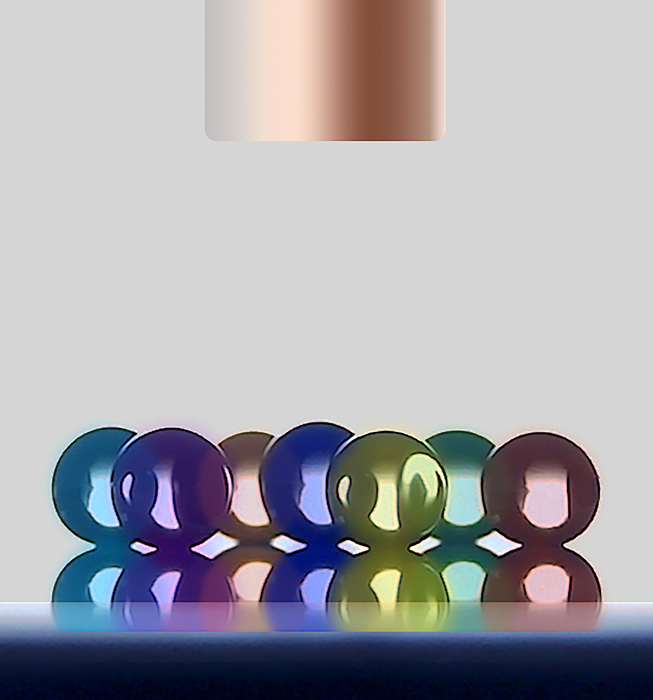Droplet manipulation has vital applications in domains such as water harvesting, heat management and chemical reactions.
 The DEST can move droplets with volume from tens of nanoliters to several milliliters and move droplets in an array. Image Credit: Jin Yuankai et al/ DOI number: 10.1073/pnas.2105459119.
The DEST can move droplets with volume from tens of nanoliters to several milliliters and move droplets in an array. Image Credit: Jin Yuankai et al/ DOI number: 10.1073/pnas.2105459119.
City University of Hong Kong’s (CityU) research team has created a multifunctional electrostatic droplet tweezer capable of accurately "trapping" liquid droplets and remotely guiding their movement on tilted and flat surfaces, and in oil mediums.
Experiments revealed that the tweezer can control droplets of varying volumes and with varied components. It has possible applications in domains like high-throughput chemical and biological analyses.
The research group is headed by Professor Wang Zuankai, Chair Professor in CityU's Department of Mechanical Engineering (MNE). Their findings have been published in the academic journal Proceedings of the National Academy of Sciences.
The existing methods for controlling droplets mostly exploit the surface force gradient built on the substrates or directly apply exterior force to the droplets. These approaches always need the droplets or substrates to be receptive to external forces.
Due to the deformable characteristic of the droplets, the current approaches for liquid manipulation deal with a number of technological challenges, like restricted operating conditions, low velocity, short distance and the need to incorporate responsive additives to the droplets.
Manipulating Droplets Using Static Electricity
To surpass the abovementioned technology limitations, Professor Wang and his team positively designed a multifunctional droplet electrostatic tweezer that employs electrostatic induction to "attract" and remotely control liquid droplets of varying types, quantities and volumes up to a distance of a few centimeters. In brief, the tweezer can shift the droplets without directly contacting them.
Stimulated by the electrostatic induction of solid materials, the researchers applied electrostatic induction in a liquid to realize droplet manipulation. Electrostatic induction indicates the redistribution of electric charges in a conductor, triggered by the effect of external electric charges.
Finally, the team effectively created the droplet electrostatic tweezer (DEST) technology, removing the need for additives and accomplishing programmable droplet manipulation without directly touching the droplets.
The DEST system comprises two parts: a tweezer with an exterior voltage applied on the electrode tip, and a substrate that is electrically grounded. The droplets are placed on the substrate, and when the electrostatic tweezer is linked to a power source, the electric charges of the droplets and substrate are redistributed because of electrostatic induction. This allows the electrostatic tweezer to accurately "trap" the droplets and direct them toward the electrodes at the tip with a suitable voltage.
The DEST is programmable. Our experiments showed that the DEST can guide the movement of the liquid droplets in open spaces, closed channels, and even oil. The DEST also allows us to manoeuvre droplets from tens of nanoliters to several millilitres, and different quantities.
Wang Zuankai, Study Lead and Chair Professor, Department of Mechanical Engineering, CityU
Different DEST Manipulating Modes
The study discovered that DEST can accomplish various modes. For instance, in the guiding mode, the droplet trails the tweezer’s movement with the electrode on its tip. In the trapping mode, the droplet moves toward the still tweezer with the electrode "switched on."
Modifying the "on" or "off" state of the electrode of the tweezer allows the droplet to travel to or remain at the preferred position of the tweezer. When a tweezer’s electrode is "off" but the adjacent one is "on", the droplet travels to the "on" tweezer, accomplishing directional movement.
In the DEST’s continuous trapping mode, as all the electrodes of the tweezer are "on," the droplet uninterruptedly moves to the following "on" tweezer.
In contrast to other droplet manipulation technologies, the DEST realizes precise and programmable droplet manipulation with unrestricted distance, high velocity and agile direction steering.
The technology provides a potential system for using droplet manipulation for chemical reactions, such as color reactions and precipitation reactions. DEST can also be used to transport small solid objects and to perform selective surface cleaning and high-throughput surface-enhanced Raman spectroscopy detection.
We also prepared a superhydrophobic substrate functionalised with silver nanoparticles, so that when the manipulated droplets move on this substrate, they carry the silver nanoparticles. This enhanced the sensitivity in the Raman measurement owing to the plasmonic properties of the silver nanoparticles in the droplets.
Dr. Jin Yuankai, Study First Author and Postdoctoral Researcher, Department of Mechanical Engineering, CityU
When one droplet is measured and removed by the electrostatic tweezer, subsequent droplets can be moved to the laser position for another measurement, and the measurement results do not interfere with each other. Another advantage of the DEST in assisting Raman measurement is that it eliminates the need for precise laser focusing on the droplet, thus greatly shortening the measurement time and achieving high-throughput droplet information detection," Dr. Jin Yuankai added.
Our technology increased the controllability and broadened the application scenarios of droplet manipulation, and simplified the application process. In addition, the substrates used in our DEST system can be functionalised, enhancing their performance for chemical and biological analysis.
Wang Zuankai, Study Lead and Chair Professor, Department of Mechanical Engineering, CityU
Professor Wang is the study’s corresponding author. The first authors are Dr. Jin and Dr. Xu Wanghuai. Other CityU scientists who took part in the study are Dr. Sun Jing, Yang Siyan, Dr. Zhang Huanhuan, and Dr. Liu Minjie, all from the MNE. Other partners are from the Institute of Microelectronics, of the Chinese Academy of Sciences.
The study received funds from CityU, the National Natural Science Foundation of China, the Research Grants Council of Hong Kong, and the Shenzhen Science and Technology Innovation Commission.
Journal Reference:
Jin, Y., et al. (2022) Electrostatic tweezer for droplet manipulation. Proceedings of the National Academy of Sciences. doi.org/10.1073/pnas.2105459119.